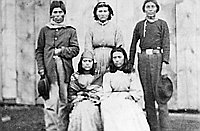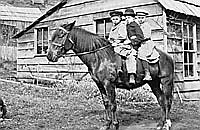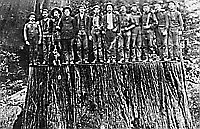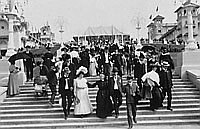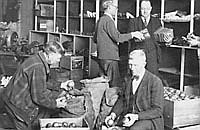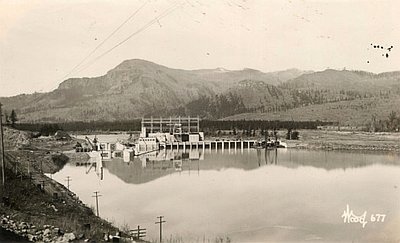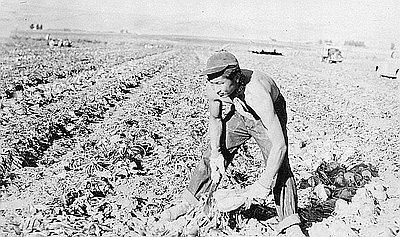Between the 1880s and 1920s, a technological revolution took place in Oregon in natural-resource extraction and processing activities. Perhaps the greatest transformation involved the transition from human and animal power to steam power in agricultural and logging operations. During the last quarter of the nineteenth century, steam-driven machines were used far beyond the region’s railroads and waterways, extending into wheat country east of the Cascade Mountains and logging operations in the Coast Range.
Steam energy was first used in Oregon agriculture to power stationary threshing machines in the wheatfields. Before long, steam-powered tractors were being used to haul reapers and combines, and gasoline-powered tractors were increasingly used after World War I.
The adaptation of steam to timber operations was even more revolutionary in terms of productivity. Although steam energy had been used to power sawmills in the Northwest since about 1850, its modification for use in the woods took another thirty years. Beginning in the early 1880s, loggers in the California redwoods and on Puget Sound developed and improved steam-powered engines to haul felled timber out of the woods. The increasing use of the so-called steam donkey speeded the movement of logs to railroad sidings or waterways. Steam donkeys were used widely by the turn of the century.
Steam-powered operations made it possible for loggers to work through the rainy winter months. By the time enterprising loggers developed an aerial twist—known as the high lead—for steam-donkey yarding activities, operators were able to haul logs to landings with one end suspended in the air. But steam-donkey logging came with a cost: a sharp increase in the accident rate and in disturbances to the forest environment. In the Coast Range and the Cascade Mountains, donkey engines remained in use until World War II, when labor shortages speeded the change to gasoline- and diesel-powered yarding machines.
Until the mechanization of most work processes following World War II, extractive industries in the Pacific Northwest were labor intensive, with a work force comprised largely of young, single males. The 1910 census reported that 90 percent of lumber-industry laborers were single males, a pattern that continued well into the automobile age. The region also had a higher ratio of rank-and-file workers to craftsmen than anywhere in the nation. It is fair to say that the Pacific Northwest was a setting with many workers and few bosses. Most people sold their labor for daily wages or piecework production; and many jobs were seasonal, especially in agriculture, logging, and canneries. Such jobs employed people from diverse communities, included Chinese, Japanese, Native Americans, Filipinos, Asian Indians, Swedes, Finns, and Italians. The boom-and-bust nature of the region’s extractive economy invited worker mobility and often encouraged union organizing activity.
The working class dominated life in labor-intensive logging communities, where one of the chief characteristics of employment was high turnover. Workers were often on the move to the next job or hiring hall, which some called a slave market. They dealt with difficult bosses and harsh working conditions by simply walking away from the job. Even after unions made inroads with many logging outfits in the late 1940s, there continued to be considerable movement in the work force.
Itinerancy characterized workers in the orchards around Medford and the Hood River valley, where a large labor force was required during the fall to pick and pack fruit for shipment to market. Thousands of harvest hands also moved across the wheatfields in Sherman and Umatilla Counties during the late summer, shifting from one job to the next until the wheat was loaded on rail cars. When horses and mules pulled the cumbersome reapers and combines, it took seventy-five horses and thirty workers to harvest a thousand bushels of wheat. With the development of mechanized equipment during the 1930s, however, horses and mules disappeared from the wheatfields—and so did most of the seasonal workers.
Although women enjoyed limited participation in the wage-earning work force until World War II, they did take jobs in logging camps as cooks, laundresses, and “flunkies” who waited tables. In the small company town of Powers in southwestern Oregon, men ran the Smith-Powers Logging Company cookhouses at first, but women began to fill those positions by the 1920s.
During World War I, women took production positions in some of the specialty wood products companies on Coos Bay. Sixteen-year-old Marguerette Therrien, whose father worked in the Coos Bay Lumber Company mill, took a job with the Coos Veneer and Box Company in 1928. Eleanor Anderson, a Finnish immigrant to Coos Bay, worked as a domestic, took a job with a wealthy family in San Francisco for a brief period, and then returned to Coos Bay to do assembly piecework in a local cedar-veneer plant. Women also worked in salmon and vegetable canneries, and a few found employment as telephone and Linotype operators, schoolteachers, and nurses. World War II marked the real watershed period for women as wage laborers.
© William G. Robbins, 2002. Updated and revised by OE Staff, 2014.
